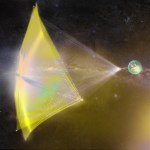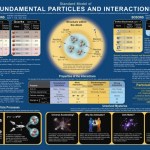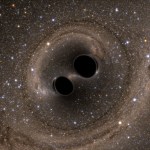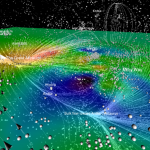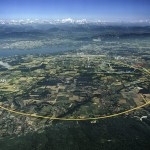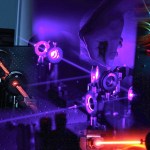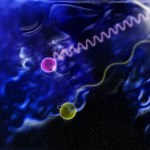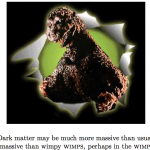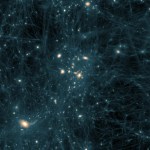Physics
"Space is certainly something more complicated than the average person would probably realize. Space is not just an empty background in which things happen." -Alan Guth
If you go back in time, earlier and earlier, things get hotter, denser and more energetic. But there's a limit to how far back you can go, and that limit doesn't end in a singularity with the birth of time and space; instead, it ends with a period of cosmic inflation, which set up the hot Big Bang as we know it.
Image credit: National Science Foundation (NASA, JPL, Keck Foundation, Moore Foundation, related) — Funded BICEP2…
It's been a while since I last rounded up physics posts from Forbes, so there's a good bunch of stuff on this list:
-- How Do Physicists Know What Electrons Are Doing Inside Matter?: An explanation of Angle-Resolved Photo-Electron Spectroscopy (ARPES), one of the major experimental techniques in condensed matter. I'm trying to figure out a way to list "got 1,800 people to read a blog post about ARPES" as one of my professional accomplishments on my CV.
-- The Optics Of Superman's X-Ray Vision: Spinning off a post of Rhett's, a look at why humanoid eyes just aren't set up to work with x-rays…
"Fundamental physics is like an art more or less. It's completely non-practical, and you can't use it for anything. But it's about the universe and how the world came into being. It's very remote from your daily life and mine, and yet it defines us as human beings." -Yuri Milner
In one of the boldest initiatives ever announced, billionaire Yuri Milner and Stephen Hawking are working on developing a "Breakthrough Starshot" project, where an advanced laser array will power a sail-driven spacecraft to speeds exceeding 60,000 km/s, taking it to the nearest stars within a single human lifetime.
A…
"It is possible to commit no mistakes and still lose. That is not a weakness, that is life." -Jean-Luc Picard
The cosmic story common to all of us -- where we came from, how we got here and where we're headed into the future -- is both amazing and daunting. But when we're first exposed to the vastness of it all in terms of both time and space, it can be downright terrifying.
Image credit: NASA and the Hubble Heritage Team (STScI / AURA), Hubble Space Telescope / ACS.
This is particularly true for young children, who often experience a huge existential crisis when they realize that not only…
"It's ironic: in order to observe the Sun, you need to go kilometers underground." -Art McDonald
Imagine you finally thought you understood how the Sun worked: how light elements fused into heavier ones, emitting energy in the process. And when you finally completed your calculations, you got nuclear physics results that matched what you observed exactly, energy outputs that fit, and a prediction for the emission of neutrinos.
Image credit: Wikimedia Commons user Borb, created in Inkscape, of the proton-proton chain in the Sun. Note the production of neutrinos.
Yet when you built the…
"The older people that one admires seem to be fearless. They go right out into the world. It's astounding. Maybe they can't see or they can't hear, but they walk out into the street and take life as it comes. They're models of courage, in a strange way." -James Hillman
The scientific enterprise has uncovered a huge number of astounding, surprising and yet fundamental truths about our Universe, what composes it and the way it works. From the formation and evolution of life on Earth to the existence and behavior of subatomic particles to the birth of the matter and radiation filling our…
"All truths are easy to understand once they are discovered; the point is to discover them." -Galileo Galilei
Galileo is most famous for his astronomical discoveries, including the moons of Jupiter, the existence of sunspots and the phases of Venus. These discoveries were a strong challenge to geocentrism, and his writings and debates helped popularize the heliocentric model.
Image credit: Wikimedia Commons user Fernando de Gorocica, under a c.c.a.-s.a.-3.0 license, of Galileo’s original (1610) sketches of the phases of Venus.
Yet, in a recent article for Aeon magazine, Thony Christie…
"When I was in high school, I was certain that being an astronaut was my goal. It was a very important time -- Sally Ride was making her first flight into space and she had a real impact on me. Those 'firsts' kind of stick in your head and really become inspirations for you." Karen Nyberg, astronaut
On September 14th, less than 72 hours after being activated at its highest sensitivity ever, the Laser Interferometer Gravitational wave Observatory (LIGO) detected its first unambiguous signal in both detectors, a signal that corresponded to the merger of two massive black holes: 36 and 29…
"You've got to learn to let go." -Matt Kowalski, Gravity
Objects in motion remain in constant motion unless acted upon by an outside force. That's Newton's 1st law of motion, and that's why you'd expect an orbiting satellite and two astronauts orbiting with it to have absolutely no relative forces.
Image credit: Warner Bros. Pictures / Alfonso Cuarón, of the poster for the movie Gravity.
Yet if you watched the movie Gravity, you saw that the two astronauts, Stone and Kowalski, definitely experienced forces relative to the International Space Station when they were hanging onto it by a…
“The slow philosophy is not about doing everything in tortoise mode. It’s less about the speed and more about investing the right amount of time and attention in the problem so you solve it.” -Carl Honore
Einstein's theories of special and general relativity tell us that there's no Universal, preferred frame of reference. But that doesn't necessarily mean that our physical Universe doesn't have an average frame of reference, one which minimizes the relative speeds of all the galaxies to one another.
Image credit: Cosmography of the Local Universe/Cosmic Flows Project — Courtois, Helene…
"Nobility, without virtue, is a fine setting without a gem." -Jane Porter
Since ancient times, gems were believed to bestow various traits and good fortunes upon those two whom they were gifted. In more recent times, we've associated gems with the time of the year someone was born, assigning each individual month a birthstone associated with it.
Image credit: Rob Lavinsky, iRocks.com – CC-BY-SA-3.0.
Yet scientifically, the individual gemstones themselves hold an impressive tale, with a variety of structures, stories and histories behind them all. What we think of as the magnificence or…
"I'm a fan of supersymmetry, largely because it seems to be the only route by which gravity can be brought into the scheme. It's probably not even enough, but it's a way forward to get gravity involved. If you have supersymmetry, then there are more of these particles. That would be my favourite outcome." -Peter Higgs
The Standard Model, in its final form, came into being in the 1960s and 1970s. From the time it was proposed in 1964, it took approximately 50 years for all of the particles within to be discovered, culminating with the discovery of the Higgs Boson a few years ago. Yet a number…
I was at the APS March Meeting last week, because I needed tp give a talk reporting on the Schrödinger Sessions. But as long as I was going to be there anyway, I figured I should check out the huge range of talks on areas of physics that aren't my normal thing-- in fact, I deliberately avoided going to DAMOP-sponsored sessions.
This also affected my blogging, so the last few weeks' worth of posts at Forbes have mostly been on March Meeting-related areas:
-- How Cold Atoms Might Help Physicists Understand Superconductors: A post about the connection between ultra-cold atomic physics and…
“In fact, the mere act of opening the box will determine the state of the cat, although in this case there were three determinate states the cat could be in: these being Alive, Dead, and Bloody Furious.” -Terry Pratchett
Quantum mechanics has been described as the spookiest of all the sciences, since it’s by far the most divorced from our intuitive reality and everyday experiences. Even though we’ve been studying it for 100 years, there are still mysteries lurking in quantum phenomena still being uncovered.
Image credit: the LEP collaboration and various sub-collaborations, 2005,…
John Oliver: So, roughly speaking, what are the chances that the world is going to be destroyed? One-in-a-million? One-in-a-billion?
Walter Wagner: Well, the best we can say right now is a one-in-two chance.
John: 50-50?
Walter: Yeah, 50-50… It’s a chance, it’s a 50-50 chance.
John: You come back to this 50-50 thing, what is it Walter?
Walter: Well, if you have something that can happen and something that won’t necessarily happen, it’s going to either happen or it’s gonna not happen. And, so, it’s kind of… best guess at this point.
John: I’m… not sure that’s how probability works, Walter. –…
"If you are not completely confused by quantum mechanics, you do not understand it." -John Wheeler
Now that LIGO has detected gravitational waves directly, it's time to examine all the different sources that they come from, and what they can teach us about the Universe. While accelerating masses in strong gravitational fields -- black holes, neutron stars and the like -- will produce gravitational waves capable of being seen by direct detection experiments, there's another class of gravitational waves that's observable through its effects on the leftover light from the Big Bang: gravitational…
"Eight solid light-years of lead...is the thickness of that metal in which you would need to encase yourself if you wanted to keep from being touched by neutrinos." -Michael Chabon
When it comes to dark matter, the most commonly considered candidates are WIMPs, or Weakly-Interacting Massive Particles. But with the failure of the LHC to turn up anything compelling at the ~100 GeV scale, or any robust hints of a new particle, for that matter, it might be time to consider another possible solution at much higher energies: a heavy, right-handed neutrino.
Image credit: public domain…
I'm going to be at the March Meeting of the American Physical Society in Baltimore next week. This is the largest physics meeting of the year, with an emphasis on condensed matter physics (which is actually the largest single area of study within physics, though media overemphasis on particle physics and astrophysics might lead you to think otherwise). The program for the meeting is, um, kind of intimidating.
So, this post has two purposes:
1) If you're also going to be at the March Meeting, let me know, and maybe we can arrange some kind of bloggy-people meet-up.
2) More importantly, if…
“Whenever I gaze up at the moon, I feel like I’m on a time machine. I am back to that precious pinpoint of time, standing on the foreboding — yet beautiful — Sea of Tranquility. I could see our shining blue planet Earth poised in the darkness of space.” -Buzz Aldrin
Seen from afar, Earth is often described as a pale blue dot. But why is our planet blue? Is it because the skies are blue? That can't be right, or the clouds and icecaps would appear blue-hued as well. Is it because the blue skies are reflected by the oceans? That can't be right either, or we wouldn't see different shades of blue…
"If you take everything we know... it only adds up to 5% of the Universe." -Katie Freese
One of the greatest advances of the 20th century was the discovery of the vast nature of the cosmos: that it was filled with billions of galaxies, each containing billions of stars, and that it extended in all directions for at least tens of billions of light years. Yet when we look out at the full gamut of all there is, the stuff that's normal matter -- made of the same protons, neutrons and electrons that we are -- can account for no more than 5% of the total energy in the Universe.
Image credit: NASA…

